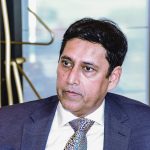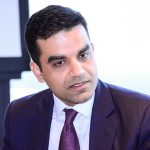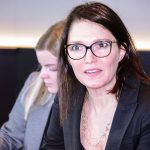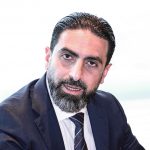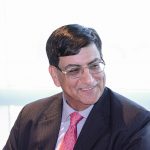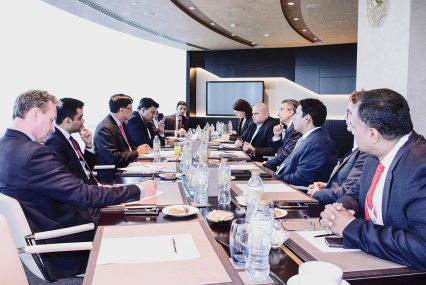
From new fintech developments to diversification efforts and the implementation of VAT, the Mena region is going through a period of change. GTR gathered a group of trade leaders in Dubai to discuss what this means for their business.
Roundtable participants:
Jason Barrass, regional head of product and propositions for Middle East, North Africa and Turkey, global trade and receivable finance, HSBC
Maninder Bhandari, director, Derby Group (chair)
Devvrat Singh Chauhan, product head, trade and receivable finance, Emirates NBD
Emma Clark, global head of marketing and corporate affairs, Falcon Group
Daniel Gould, CEO, Anglo-Gulf Trade Bank
Rahul Jayakar, head of global transaction services, products and trade, Mashreq
Yazan Al Nasser, chief supply chain finance officer, Tawreeq Holdings
Manoj Menon, head of global transaction banking, First Abu Dhabi Bank
Kersi Patel, head of trade finance, Middle East and North Africa, MUFG
Arup Roy, head of global trade and receivables finance, Saudi British Bank (SABB)
Birju Sanghrajka, managing director and head of trade, Africa and Middle East, Standard Chartered
Saurabh Sharma, trade finance sales, Abu Dhabi Commercial Bank
Bhandari: Over the last few years we have seen both great results and a lot of turmoil in the region. What do you think has happened as far as the economic landscape is concerned, and what does it forebode for us going forward?
Jayakar: In the previous GTR Mena roundtable discussion, which was held around the same time last year, the general consensus was that we had recovered from the turmoil of 2015/16 and the outlook for 2017 was positive. But the business growth has been sporadic and overall economic growth lower than expected. Growth in real GDP in the UAE last year was 1.3% as per the IMF’s data, and the wider region showed similar subdued growth numbers.
Incidentally, what is happening in the market, especially in trade finance, is that most of the banks have started focusing on better quality of risk, which has resulted in higher facilities provided to clients which have a better risk profile, and hence more competition. It’s a very competitive market, with competition from existing players, new players and fintechs.
Sanghrajka: To an extent I agree with Rahul. 2017 looked like it was going to be a much better year, but really what happened is that the turmoil of 2015/16 tapered, and clients were dealing with the lag of extended payment or deferred payments. That had a material impact in 2017. As a result, the bankable clients reduced and banks are all targeting the same clients. There is a decoupling between risk and return on those names, and margins are shrinking.
However, the wider region is showing some interesting developments. If you look at the improving security situation in Iraq, for example, banks are traditionally capped at the one-year tenor, but maybe we can look at a little laonger tenor and try to do some interesting trade finance structures on the back of it. Saudi is another interesting space, given the reform agenda. We believe the UAE is not capped out. We believe that this year is going to be a better year and that the wider region is going to create new opportunities for us.
Bhandari: Does that mean better numbers for the coming year?
Sanghrajka: It is still early days. What we saw anecdotally towards the back end of last year is that there was a stockpiling of inventory by clients, given the view on increased costs associated with the implementation of VAT, so we actually saw clients’ financing requirements increasing. We believe the same has happened in other banks. What should be interesting to watch now is whether, six weeks into VAT go-live, those financing requirements will come down. The proof of whether this means better numbers really is in the next three months.
Bhandari: Emma and Yazan, both of your institutions are focused on a structured transactions type of approach – does that reflect optimism, or does it mean that you need to be more secured in what you are doing towards increasing the flows?
Clark: From a Falcon perspective, I will endorse what everybody else is saying. The economy has not been as good as everyone hoped 2017 would be, and it has been a challenging year for us. In terms of funding the SMEs, we have certainly taken a step back and focused more on the larger companies, and that is very much client-driven.
Clients come to us because of our structuring capabilities and our ability to do what banks can’t do, take risks banks can’t take, and this is only possible because of our balance sheet capabilities. If a bank can do it, it will always be better and cheaper than us. If it is a bit more structured and a client is willing to pay for it, we can probably add value.
Al Nasser: Regardless of the challenges, there is still a gap in the market. Indeed, the ICC has highlighted that there is an almost US$1.6tn gap in the finance market. The SMEs are underserved and underfinanced in most of the markets. This gives you an indication of the need for alternative financing. What is needed are complementary solutions to the traditional financing. The banks’ role in offering the traditional structured products is still essential, but companies like ours are necessary to serve this market.
With supply chain finance, or the factoring model that we have adopted, we disclose non-recourse factoring, which is structured to take the risk of rated multinational corporations, government authorities and listed companies in the region, who deal with a huge network of thousands of SMEs. It is offering a platform for them to offload these receivables off balance sheet, because it is fully non-recourse to them, at a very competitive rate, taking the credit risk of the client. However, this needs the full engagement of all parties involved in terms of the assignment requirements, and the transparency in terms of disclosing information and the adaptability to get into the new era of digitising. This is also a platform for the banks to contribute by still having the traditional structure.
Clark: One of the key points with alternative financers is that they are not there to replace the banks. They are there to do what the banks don’t. We are seeing many entrants come into the market in the fintech space on the SME side, and those that will survive will be those that do what the banks don’t do.
Bhandari: Daniel, you are launching a new institution, and that obviously reflects a degree of optimism as to what the future holds. Why would one want to do that now?
Gould: I would first of all challenge the assertion that opening a bank is a signal of optimism. I have spent my life in situations where the best time to go in is when things are not rosy, because that is when others are retrenching, and you have a chance to make an outsized impact.
I come to this roundtable very much as an outsider, in the sense that I’m not in the region. It is very interesting to listen to the alternative versus traditional agents, but for a new entrant like Anglo-Gulf Trade Bank it might also be about seeing what we could do better than the existing banks. It should not be thought of as binary: it is not that you either do it the traditional way or you do it the alternative way. There are things that can be done more effectively and faster. Let us focus on trade finance. We can talk about how big or little the trade finance gap really is, but there is definitely a market there. The question is, how do we address it? I think there are still many things to be done in a traditional sense.
Bhandari: Arup, how applicable are these thoughts as far as your market, Saudi Arabia, is concerned? What opportunities do you see?
Roy: For last couple of years, Saudi Arabia has been passing through quite an interesting time. The impact of decline in oil prices led to rationalisation of infrastructural projects and change in consumption patterns. This together with ongoing fiscal measures have resulted in continued decline in overall trade volume for KSA.
On the positive side, a series of transformational initiatives are currently underway, from social, cultural and economic diversification perspective.
A special emphasis is being placed towards accelerated execution of logistical infrastructure projects supporting trade, with an aim to position Saudi as a re-export hub. Another area which is receiving attention is growth in non-oil exports.
On future outlook, our assessment is that the declining trend will continue until the middle of 2018, reaching the bottom and thereafter should demonstrate an upward movement. The reason for that, in my opinion, is threefold. First, I believe oil prices have seen the bottom and are slowly stabilising at a level close to the anticipated price as factored in current year’s budget. Secondly, the recent compensatory measures together with increased level of employment for Saudis, particularly the female population, are adding to the demand. The third important aspect is the implementation of ongoing strategic initiatives under Vision 2030, such as introduction and expansion of the entertainment industry, women being allowed to drive, allocation of funds for strategic projects, improvement of legal framework for businesses, etc, which should result in growing activities.
Gould: As an outsider, if I could be the devil’s advocate, I’ve lived in Russia for a long time, I’ve lived in other emerging markets, and I have seen other economies that may have a skewed industrial focus. Every time there is a crisis or an oil price reduction, there is talk of transformation and of commitment to a structural change, and yet, every single time, once the going gets better, the talk of transformation evaporates, and the residual outcome is minimal. So I’m curious. What do you think is going to be different?
Roy: These are very pertinent questions. But I think the current transformation drive has reached a stage where it is unlikely to reverse. One of the reasons is that the change within is being driven and embraced by youth, both male and female, and is not limited to economic transformation but goes beyond to influence the socio-economic fabric of KSA. The increased focus on entertainment, overall women empowerment and some of the other liberalisation-related moves indicate KSA’s intention to align with what is happening globally.
Bhandari: Let’s move to an associated topic, the introduction of VAT. Saudi Arabia and the UAE have already implemented it, while Oman and Kuwait are still waiting. What is the perspective on that? To what extent do you think it will temper enthusiasm?
Sharma: I think the only reason they are waiting is to learn from the experience of KSA and the UAE, so we should see them coming onboard shortly as well.
VAT will be overall beneficial for the commercial segment. There would be an associated short-term pain, and of course that entails a cost on the SME to comply, but the significant benefit of VAT to banks would be the associated paper trail. One of the key hindrances in this market is the opaqueness of the financial statement. The banks would have another means of validating the financial position, standing and volume through the VAT paper trail, and that should help banks to assess the SME clients, gain more confidence in their assessment, and perhaps have better quality of assets. So, in that sense, I think VAT, in addition to the macro view of balancing the government budget – which is always good – has an added advantage in terms of enabling more transparency in the system.
Roy: It has not been easy for Saudi Arabia to implement VAT as the timelines given to do so was short. However, banks, along with their clients, have worked very hard to achieve that. The first VAT return is scheduled to be submitted shortly. As per initial indication, it has been accepted and implemented smoothly through the country, and will provide an additional income stream for the government.
Chauhan: The introduction of VAT is a very significant change, since it is the first time that any tax has been introduced in the region. It is quite commendable that it was implemented on time, as per the initial deadline set by the authorities, and a lot of effort went in from corporates and banks in terms of getting the systems and processes in place. There was also a fair degree of familiarisation required since the concept of VAT was completely new for this region and the resources and expertise were not widely available.
Although it may be painful in the short term in regard to implementation, we feel that over the medium term it will result in positive developments. While this is not a silver bullet that will solve all problems, it will certainly bring more transparency in the paperwork process and help attract the right kind of trade to the region. It will also increase government spending and economic activity, which has a cascading positive effect on the economic outlook.
Patel: Although oil prices have witnessed a marked improvement over the last year, the fiscal adjustment process is far from complete for the GCC countries. Efforts on reining in current expenditures, prioritising capital expenditures to focus on the quality and efficiency of project spending, and plans to raise non-oil revenue collections – primarily through corporate taxes, import duties and the implementation of VAT – are all accompanying efforts aimed at improving the fiscal position of GCC governments.
Further to this, collection of VAT will improve financial visibility of the underlying businesses – this is a huge indirect benefit for financial institutions lending to smaller mid-market customers and SMEs where financial visibility may not always have been crystal clear. Implementation of VAT is an important part of the larger economic adjustment story for the region, and while there may be pain in the short-term, I see it as a long-term positive for the GCC countries. I believe that the other GCC countries will soon follow the lead set by the UAE and KSA on this front.
Bhandari: When I speak to financial institutions, they often say that the only way to expand the size of the pie is to go further geographically than they have traditionally. They say Africa is the future. Yet the risk appetite on that region is always very limited. What is your take on that?
Patel: Africa, especially for UAE-based companies, is a key future market. The UAE is already home to over 4,500 Chinese companies and is a key trading hub on China’s Belt and Road Initiative connecting China with Africa – which is both a source for raw materials and a market for finished goods for China. China is the UAE’s largest trading partner, and around 60% of Chinese exports to the UAE are re-exported to Africa and Europe.
Menon: There is plenty of opportunity in Africa. FAB’s aim is to further develop our entire Mena franchise. We have a strong presence in many countries already, and we are expanding into Saudi Arabia, so we are building on a solid position within the region.
Asia is another key growth market. We have a good presence in key locations in the continent, which means that we have the roots to grow. Our aim is to organically grow our international operations and also consolidate our position in the UAE market.
Barrass: I have a slightly different angle on expansion. Obviously, all banks want to increase the volume of business that they are doing. For us it is not necessarily opening up in a new country, HSBC already has a large network globally, particularly in Asia. So for us, deepening our client experience is more important. We look at some of the key initiatives, such as the Belt and Road Initiative. For us, it is all around following that supply chain further down, helping our clients link up the key trading channels and becoming relevant to their expansion ambitions.
Additionally, becoming a technology partner is also key. Clients are now looking at how technology can shorten their supply chains, remove costs and risks. A bank that can become good at both will become a relevant partner.
Jayakar: We follow our clients’ trade flows, which originate in Asia and end in Africa or vice versa, with the UAE as the hub for this flow. The east-west corridor gives us a unique advantage to handle end-to-end trades of our clients, giving us a competitive edge.
However, at some point in time, non-bank industry participants will want to take advantage of the fast-growing markets of Africa and Asia, resulting in the pie shrinking. In this scenario, one’s ability to cut down costs becomes imperative.
Managing cost through digitisation in trade processes is a key focus area. We have been successful in migrating our clients onto digital platforms and have also automated internal processes for trade, which has cut down the cost significantly. This cost saving will help us to maintain our edge in this highly competitive market.
Bhandari: Is this digitisation effort being done to assist in the cost structure, for want of margins, or is it because that’s what the client needs?
Jayakar: Clearly, clients’ needs vary from one to another. The client needs a solution, not necessarily just in form of an electronic platform, but overall experience. Hence, in order to service the client better, it is very important to automate. So, that entire process around OCR (optical character recognition), ICR (intelligent character recognition), trying to read the trade documents and digitise them, is very important. It will enable service providers to process many more documents for client. Processing something, which previously took between 12 and 13 hours, can now be brought down to one or two hours through process automation. The overall solution has not changed, but my ability to provide the solution faster has tremendously improved and hence the client experience.
Chauhan: There are two parts of the story – optimisation and innovation. For optimisation, banks are digitalising their internal processes for faster delivery. They are exploring technologies like OCR, machine learning and algorithms for processing, which have now reached some level of maturity for banks to leverage. There is another angle of serving some of the other client needs through innovative solutions. This could be providing access to financing through customised products or allowing clients to share data with the bank and other parties electronically. We conducted one such proof of concept where all participants in a trade transaction were on a single blockchain network. This included shipping companies like Aramex, regulators like Dubai Trade and Dubai Customs, as well as other parties. This provides everyone with a complete audit trail and transparency on documents. We are seeing a lot of clients, especially in the commodities and government sector, coming to us and asking for those innovative solutions.
Bhandari: At the moment, where everybody has got a limited budget, if the choice is between new products, filling existing gaps and needs versus going down the path of digitisation for a new horizon, what does the client want?
Chauhan: In terms of product coverage, I think most banks are already offering the majority of the trade products, ranging from core trade to structured trade, receivables financing, etc. This limits the opportunities for new product introductions. Therefore, digitisation and innovation are the next differentiators where banks can offer additional value to the customer. It can be on blockchain or any other platform which allows the bank to effectively solve the customer’s problems.
Al Nasser: It all comes together. As everyone is saying, the client wants the solution and the liquidity. However, it’s very difficult to get the best benefit out of alternative solutions without digitisation. For example, factoring has both counterparties involved in every single transaction on several levels or steps. If we are going to do this manually, it will be physically impossible and it’s not going to add value.
Despite that, digitisation is sometimes a harder sell. Today even if we manage to engage two counterparties to finance a transaction of a certain contract, once you put the digital aspect on the table, which will take people out of their comfort zones, it can be a barrier.
Bhandari: To what extent do you believe that blockchain is going to happen? Are clients going to accept it?
Clark: Eventually it will happen. How it will look and feel, I don’t know. We are continually utilising enhanced technology. The challenges we have are, as an alternative financier, how do you know that it’s your inventory sitting there in the emerging markets if you’re basing it on a system which these businesses don’t even have, and don’t care about, and if there’s a way to get around the system they will?
If you’re going out into these countries with emerging economies and you look at their technology, they’re still faxing. I think the ultimate solution or the ideology of blockchain technology on a truly global scale is still in its embryonic phase.
Sanghrajka: We will get there. Tech in trade, trade in tech, however you want to look at it, there are three models. One is government led, for example, Singapore and the national trade platform they have launched. For this, you need regulation to drive the agenda. Another is a consortium-led model. There are many out there. Some of the world’s largest trade banks, including Standard Chartered, have got together to create a bank-agnostic utility for open account trade. We are inviting regional banks to join us. The third would be your local, vendor-led solutions. These will serve a specific market or client need and cannot be ignored as they have the potential to grow. Clients are already talking to banks about what is possible.
I think the holy grail would be matching digitisation with traditional trade finance and then overlaying it with regulation, and integrating it into a global supply chain.
Barrass: I think it is going to be a journey. We’re not going to wake up one day and experience a big bang with blockchain. Key is obtaining consensus and limiting digital islands. Having 50 banks with different solutions is not client-centric. We are making good progress in R3 using the Corda technology and this is a good example of how banks are working together on a solution for the future.
Patel: Dubai is the third-largest re-export centre globally, behind Hong Kong and Singapore. The eTrade infrastructure implemented by Dubai Trade compares very favourably with what is in place in Hong Kong and Singapore. It is not far-fetched to think Dubai Trade’s infrastructure could be rolled out to Dubai World’s global network of over 50 ports, or indeed it may get linked to the eTrade networks in countries like Japan, Singapore and Hong Kong. I think a development like this across countries and regions can happen quicker than we anticipate, and this can potentially lead to trade digitisation progressing very quickly.
Rather than technology, infrastructure or market interest, in my opinion it is the evolution of regulation around trade digitisation that seems to be lagging. This work will be largely led by trade bankers working with ICC, so is the ball in our court to ensure that we don’t end up slowing progress of trade digitisation?
Roy: The success of technology to a large extent will depend on the ease of its use. We mentioned a couple of examples. Some may be using faxes, but think of Kenya, which is home to the mobile money boom. If we want to entice the entire spectrum of SMEs to use technology for their trade transactions, we need to ensure that it remains user-friendly. We should be in a position to demonstrate the value to the clients, either in terms of costs and/or other benefits such as client experience, speed and accuracy of transactions. We have seen many technologies which have failed owing to limited corporate client acceptance.
Gould: It’s very interesting that Birju mentioned the three ways that digitisation will be driven: the government-led, the international consortium and the local vendor. I think we as capitalists have forgotten the importance of governments. If I just look back 25, 30 years ago, the World Wide Web and the standards which were imposed then were done via a government institution that was then agreed and put in place by the rest of the global governments. And when you get critical mass, that is when everyone else subscribes.
Therefore, instead of thinking about how we create a better blockchain experience that can win a market competition, why not think about how to get the governments talking together and then going for a standard? If we spend our lives debating which standard is better, then we are going to miss the speed with which we can move if we just make a choice.
Menon: The UAE government is embracing rapid digitisation and banks are moving fast to meet client demand. With the introduction of sandboxes in Abu Dhabi and Dubai, new fintech players are arriving and there is a great deal happening in the digital space.
Jayakar: I agree that that blockchain adoption needs to be regulator driven. To give an example, just recently, the Saudi Arabian Monetary Authority (SAMA) talked about a collaboration with Ripple for its cross-border payments. With this, practically every single bank regulated by SAMA will work towards adopting a common platform because the regulator has come forward and said, this is a technology that you will use for making cross-border payments out of Saudi.
Bhandari: Finally, what is your 2018 outlook for the market? What should clients expect?
Sharma: Our expectations for 2018 are influenced by the Dubai government’s budget announcement and the expectation of spending by Adnoc, which announced a total outlay of US$109bn for the next five years in both upstream and downstream segments. We expect 2018 to be a good year for the contracting clients. That should put more money through the systems and there will be more demand from the commercial segment for banking facilities. Therefore, we are expecting a growth in the SME contracting segment in 2018.
Roy: Given the size and shape of this region, it will perhaps be easier to demonstrate the leadership position than in Europe and the rest of the world, because the governments are thinking in the same direction. There is a focus on digitisation, on automation and on transformation everywhere across the Middle East. Therefore, perhaps if we can all put our heads together, we can take a leadership position in terms of demonstrating digital transformation within GCC.
Patel: I think we should remember that directly or indirectly, regardless of the recent efforts to diversify, and the UAE has done a very good job on this front, we are still largely an oil-driven region. I don’t think that we should get complacent with the rally in oil prices that we have seen over the last many months; I think the price range of US$65/70 per barrel is a reflection of a weaker dollar rather than a stronger global demand for energy. Therefore, while most current indicators point towards higher overall exports and imports flow for the region in 2018 as compared to the last two years, we could be disappointed by how quickly oil prices may move downwards and negatively impact the regional sentiment and our businesses. Overall, I am cautiously optimistic.
Jayakar: If you look outside the window, you will see the hectic commercial activity on the commercial side, in the UAE and the wider region. This commercial activity gives 2018 an optimistic outlook. However, one needs to still take a cautious approach and keep the controls and the risk elements in focus while trying to make the most out of the visible activity.







